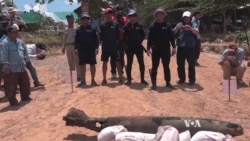When 42-year-old fisherman Yor Dieb snagged his net on an object just meters from the Mekong River bank here, he had little choice but to dive down and untangle it by hand.
The net had wrapped itself on the tail of a live 227-kilogram bomb, a relic of the 1970-1975 civil war when the United States dropped hundreds of thousands of tons on Cambodia, a so-called "sideshow" to its battle in neighboring Vietnam.
There wasn’t much Yor could do – until late last month, when a specialist in demining came to his village 30 kilometers southeast of Phnom Penh, asking whether residents had found unexploded ordnance, or UXO, in the river.
Yor told them he had, and on Thursday, Cambodia’s newly trained UXO dive team from the government’s Cambodian Mine Action Center (CMAC) dived the 6 meters, extracted the Mk-82 bomb from the Mekong's murky depths, brought it ashore and defused it.
Grueling training
It took the nine-man dive team two years of training to get to this point. Forty men started the course; none could swim. Their grueling training involved night dives as well as diving "blind" with blackened scuba diving masks to simulate the conditions of the Mekong. Visibility of 10 centimeters is a rare treat in that river, and strong currents are the norm.
The nine who succeeded – now among the most specialized divers in the world – were trained by the Golden West Humanitarian Foundation, a U.S.-based nonprofit organization that works on demining. The U.S. State Department funds the training.
Reducing safety risks
Addressing public safety risks are central to the program, said country director Allen Dodgson Tan. Mortars, artillery projectiles and other unexploded ordnance lurk in the mud and watery depths, snagging fishing nets and tempting scrap-metal scavengers.
"Is a fisherman getting his net caught in it? Is a boat going to hit it?" Tan said. "Are they going to build something like a bridge where they need to clear an area for a pylon? Are they going to dredge there? These are the kinds of things we look at, right?"
Caution is understandable. The international nonprofit MAG (Mines Advisory Group) reported that Cambodia is "severely affected by the presence of landmines, cluster munitions, air-dropped bombs and other unexploded ordnance," dangerous residue from a civil war that ended in 1993 and from U.S. bombings, from 1965 to 1973, against the Khmer Rouge.
MAG said an estimated 9,000 suspected mined areas, including those on land, still must be cleared. The Cambodia Mine/UXO Victim Information System reported 19,684 people were killed and 44,630 injured by landmine and ordnance explosions from 1979 to 2013. The numbers have been declining as because of the demining work, which includes efforts by groups such as MAG and Golden West.
Some ordnance that landed in Cambodia’s rivers will never be removed, Tan said, because "it’s not going to do anyone any harm."
But bombs like the one in Lvea Em district are a problem.
Mission details
Under a blazing sun, the team worked from Yor Dieb’s wooden boat. First, CMAC’s chief diver, Sok Chenda, descended 6 meters to dig away the mud surrounding the bomb. Next, a colleague went down to connect the bomb to an inflatable balloon that quickly wrenched it free from the riverbed.
With the most dangerous part of the mission over, they towed the bomb, suspended a meter below the surface, to shore at the ferry landing, which the police had emptied of villagers.
Mike Nisi, a former U.S. Navy diver who trained the team, works for Golden West as the technical adviser on the underwater program. Although the fuse in the nose sheared off – likely when it hit the water – the one in the tail was still live, he says, which meant the bomb was still dangerous. Other factors added to the dangers of the operation.
"The fact that it’s underwater in little to no visibility with high currents and all the other possible elements that can come into play – with other fishing boats coming too close, they can affect our operation. Currents changing, that can affect it," Nisi said. "So many unforeseen elements ... can make this even more dangerous than it already is."
Good feeling
Sok Chenda, the dive unit’s leader, said he was pleased with his team’s performance.
"It’s good, and the first time, and it’s difficult and dangerous,” he says, adding that visibility was very poor – just 10 centimeters. “But we can do [this job] by feeling."
In the penultimate stage, the bomb was driven to a distant rice field where Golden West had assembled its remote-controlled mobile band-saw cutter. From a safe distance, the team sawed off the nose and tail, rendering the device safe.
In the coming days, Golden West will process the 113 kilograms of explosives in the bomb into 1,000 explosive charges that demining groups such as CMAC use to blow up landmines – another scourge of decades of war that, along with the U.S. bombing, brought so much destruction. It is a classic case of turning swords into ploughshares, said Tan.
There’s little doubt that other bombs are in Cambodia’s rivers, and approaching villagers is a good way to find out where they are. To that end, says Golden West’s Nisi, the team will continue getting the word out to people in the provinces: “If they find anything, we have numbers for them to call – we pass out cards everywhere we go.”
The team’s next stop will be the site of an ammunition barge that was sunk in the 1970s, and which is under a meter of mud.
“We have to first dredge it and then we’re going to find out whether there’s any ordinance on there or not," he says. “That’s what we’re working on after this."










